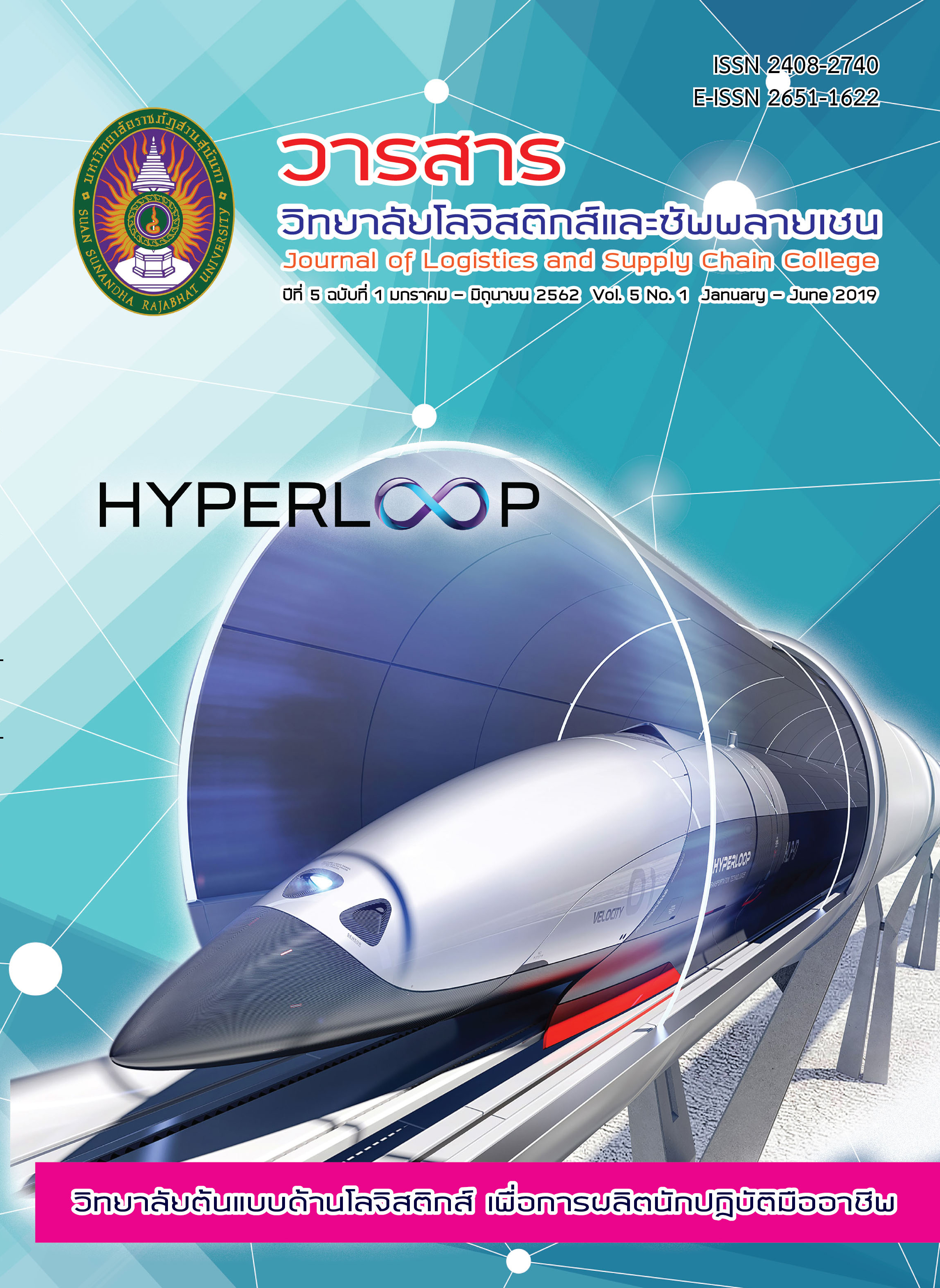Innovative Products and Sustainable growth of Cosmetic Business
Abstract
Since, the past decade many countries have paid more attention on environment’s condition. Meanwhile, the concept of “sustainable economy” that placed an importance on the ethical and economical utilization of natural resources for the growth of businesses, as well as, people and society, has emerged. This form of economy has received attention and was considered a new way to develop global economy. For the businesses, which were the small units of economy, this concept was viewed as a challenge in a way that the they have to adjust themselves to keep up with this new trend of economy. Which gave significance on sustainability. Although, cosmetic industry has generated high marketing value, but it concerns the use of chemical ingredients that may be harmful to the consumers. Moreover, cosmetic manufacturing process may have impacts on environment. However, due to the increase of demand for sustainable business operation, cosmetic businesses need to adjust themselves to be able to succeed under the changed situation. The need to be adjusted was driven by 4 factors, which were; 1) ethical 2) trend of regulation and law 3) technology advancement 4) economic benefit and long run growth. Moreover, in order to be sustainable successful. The cosmetic businesses had to 1) initiating sustainable innovative and friendly-manufacturing process. 2) building corporate image and 3) building strategic alliance.
References
Abdul-Rashid, S. H., Sakundarini, N., Raja Ghazilla, R. A., and Thurasamy, R. (2017). The impact of sustainable manufacturing practices on sustainability performance: Empiricalevidence from Malaysia. International Journal of Operations & ProductionManagement, 37(2), 182-204.
Announcement of the Food and Drug Administration regarding the details of the production, sale or import of cosmetics. (2014). Government Gazette No. 130.2013
A. Sahota. (2014). Sustainability: How the Cosmetics Industry is Greening Up: John Wiley & Sons, 2014. Association of Southeast Asian Nations. (2006). ASEAN Cosmetic Documents. Retrieved from https://elib.fda.moph.go.th/fulltext2/word/14697/1.pdf
B. Giddings, B. Hopwood, and G. O'brien. (2002) “Environment, economy and society: fitting them together into sustainable development”, Sustainable development, vol. 10, no. 4, pp. 187-196.
Brand buffet (2018). Ladies and endless Beauty. The Celebration of Cosmetic Business. Retrieved from https://www.brandbuffet.in.th/2018/06/beauty-market-in-set-2018/
Chuang, S.-P., and Yang, C.-L. (2014). Key success factors when implementing a green manufacturing system. Production Planning & Control, 25(11), 923-937.
Chung, K. H., Wright, P., and Kedia, B. (2003). Corporate governance and market valuation of capital and R&D investments. Review of Financial Economics, 12(2), 161-172.
Eccles, R. G., Miller Perkins, K., Serafeim, G. (2012). How to Become a Sustainable Company, MIT Sloan Management Review, Summer
E. R. Gray, and J. M. Balmer, “Managing corporate image and corporate reputation,” Long Range Planning, vol. 31, no. 5, pp. 695-702, 1998
Frank-Martin, B., and Peattie, K. J. (2009). Sustainability marketing: a global perspective. In:Wiley.Government Gazette No. 1 3 1 , Special 2 3 9 previous five.2014.
Hansmann , Mieg & Frischknecht . (2012) “Principal sustainability components: empirical analysis of synergies between the three pillars of sustainability”, International Journal of Sustainable Development & World Ecology Vol. 19, No. 5, October 2012, 451–459. Retrieved from https://www.ethz.ch/content/dam/ethz/specialinterest/usys/department/documents/studium/umweltnaturwissenschaften/diverse/2012-Hansmann-etal-Principal-sustainability-components.pdf
Hart, S. L., and Dowell, G. (2011). Invited editorial: a natural-resource-based view of the firm:fifteen years after. Journal of management, 37(5), 1464-1479.
Hassan, M. G., Abidin, R., Nordin, N., and Yusoff, R. Z. (2016). GSCM practices and sustainable performance: A preliminary insight. Journal of Advanced Management Science.
H. Min-Xue, H. Yong, and D. Ya-Ni. (2012) "How to improve customer participation through customer Education: From the perspective of customer readiness." pp. 251-254.
I. E. Maxwell. (2009) Managing sustainable innovation: The driver for global growth: Springer Science & Business Media.
I. Guijt, and A. Moiseev. (2001) “Resource kit for sustainability assessment,” IUCN, Gland, Switzerland and Cambridge, UK.
J. Elkington. (1994) “Towards a sustainable corporation: win-win-win business strategies for sustainable development,” California Management Review, vol. 36, no. 2, pp. 90-100.
J. Sarkis, J. J. Cordeiro, and D. A. V. Brust. (2010) Facilitating sustainable innovation through collaboration: Springer.
Majerova, J. (2015). Analysis of Slovak Consumer's Perception of the Green Marketing Activities. Procedia Economics and Finance, 26, 553-560.
Manager online. (2015) Cosmetic market grew silent but a tremendous value [internet]. Manager 3600. Retrieved from: https://www.gotomanager.com/content/%E 0%B8%95%E0. Ministry of Health to establish rules and notification methods produce for sale. Or imported cosmetics,. Government Gazette No. 130.2010; 36 : 15.
Nadanyiova, M., Kicova, E., and Rypakova, M. (2015). Green marketing and its exploitation in Slovak companies. Procedia Economics and Finance, 26, 219-226.
Orlitzky, M. (2008). Corporate social performance and financial performance. In The Oxford handbook of corporate social responsibility
Osman, A., Othman, Y. H., Salahudin, S. N., and Abdullah, M. S. (2016). The awareness and implementation of green concepts in marketing mix: A case of Malaysia. Procedia Economics and Finance, 35, 428-433.
Prachachat online. (2015). Retrieved from: https://www.prachachat.net/news_detail.ph p newsid=1436776000
Regulatory. Minutes of the 20th ASEAN Cosmetic Committee 30 and the meeting of the 19th ASEAN Cosmetic Scientific body [Internet]. (2018). Retrieved from https://ecosmetic.fda.moph.go.th/frontend/theme_4/document_category.php?Submit=Clear &Types=
R. G. Eccles, K. M. Perkins, and G. Serafeim. (2012) “How to become a sustainable company”,MIT Sloan Management Review, vol. 53, no. 4, pp. 43.
R. Hansmann, H. A. Mieg, and P. Frischknecht. (2012) “Principal sustainability components: empirical analysis of synergies between the three pillars of sustainability”, International Journal of Sustainable Development & World Ecology, vol. 19, no. 5, pp. 451-459.
R. Nidumolu, C. K. Prahalad, and M. R. Rangaswami. (2009) “Why sustainability is now the key driver of innovation,” Harvard business review, vol. 87, no. 9, pp. 56-64.
Royal Thai Government Gazette. (2015). Cosmetics Act B.E. 2558 (2015). Retrieved from https://www.fda.moph.go.th/sites/Cosmetic/Shared%20Documents/Laws/Cosmetics%20Act%20B.E.%202558%20(2015).pdf
T. Gable. (2009) "Image as part of corporate strategy: Building reputation and results for any business", 2009
United States Environment Protection Agency (2018). Retrieved from https://www.epa.gov/environmental-topics



